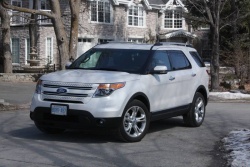 2011 Ford Explorer Limited 4WD. Click image to enlarge |
|
Related links
Manufacturer’s web site |
Review and photos by Chris Chase
Photo Gallery:
2011 Ford Explorer
It pays to be careful with the products that bring in the dough. Ford learned its lesson about that with the Five Hundred and Freestyle, the cars that (temporarily) replaced the Taurus in 2007. Those two tanked big-time, and it’s debateable whether the Taurus, which has since been redesigned (again) into a very well-sorted full-size sedan, has ever recovered from that gaffe.
In Ford’s SUV line-up, the Explorer name commands the same kind of respect that the Taurus once did. It’s popular, but it could be argued that its truckishness kept it from being more popular, especially with drivers who choose a mid-sized SUV with a view to flexible family transportation, rather than for off-road readiness or towing capability. It was with them in mind that Ford decided to move the 2011 Explorer to a unibody platform, in place of the old version’s body-on-frame design.
Initially, the only engine on offer is a 3.5-litre V6 that’s used widely throughout the Ford line. With its 290 horsepower and 255 lb.-ft. of torque, it replaces a 4.0-litre V6 (210 hp; 254 lb.-ft.) and a 4.6-litre V8 (292 hp; 300 lb.-ft.). Despite torque that only matches that of the old V6, Ford says the new Explorer will tow 5,000 pounds (2,267 kg); a 2010 Explorer with the V8 could haul 3,500 pounds (1,588 kg), but could handle up to 7,130 pounds (3,234 kg) when properly equipped.
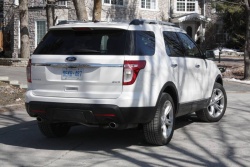 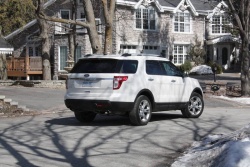 2011 Ford Explorer Limited 4WD. Click image to enlarge |
The old Explorer was no pipsqueak, but its replacement is even more visually imposing. More importantly, it’s bigger inside, at least in the front seats, where there’s notably more leg and foot room. Any extra space in the second row is less obvious, where legroom is good, but not as generous as I expected to find in a vehicle this large. Three-row seating is standard, and it’s in the third row that you’ll find a more usable environment than in the previous-generation truck. There’s enough leg- and headroom for average-sized adults, but only children will likely put up with sitting back there for long periods of time. The front seats are long-haul comfortable, a common trait across most of the Ford line-up.
Limited models get standard adjustable pedals, but I think many may wish these were available in the lower trims, too (they’re not, even as an option).
One of the bigger benefits of this redesign is a lower step-in height compared to the last generation Explorer, which makes it a more viable vehicle for everyday use.
For the not-so-everyday owners who miss the off-road abilities afforded by the old Explorer’s truck-based construction, Ford’s solution is a Terrain Management System that’s standard in all four-wheel drive models. Through a console-mounted knob, this allows the driver to set the drive-train to one of four settings (normal, snow, mud or sand) to optimize performance on a variety of surfaces. A muddy backroad was a good proving ground for the “mud” setting; while the truck got through just fine in normal mode, the system makes a tangible difference in transmission shift feel and throttle tip-in with a view to helping the driver maintain momentum and avoid getting stuck. Aside from normal, the most useful setting for most drivers will be snow mode, which orders quicker upshifts and softer shifts in general to help maintain traction in wintry conditions.
 2011 Ford Explorer Limited 4WD. Click image to enlarge |
There’s also a hill descent control setting that keeps a consistent speed down steep off-road grades, and stability and traction control are standard across the line.
Ford says it benchmarked vehicles like the BMW X5 and Audi Q7 for the Explorer’s on-road performance, and it shows. But rather than driving like a German vehicle (it doesn’t), the Explorer drives like a Ford – high enough praise considering how consistently impressive the Ford crossover line-up is at the moment.
In spite of its off-road bias, the Explorer handles paved roads just as sharply as its smaller, more road-focused sibling, the Flex. A firm suspension helps, limiting body lean in turns and, as a side effect, contributing to a ride just on the annoying side of firm. I’ll take the hard suspension if it means I can bend a vehicle this large into a corner with so much confidence.
Also surprising is the Explorer’s impressive steering feel, courtesy of a variable-assist electric power assist set-up. Steering is light at low speeds for easy parking, and gets noticeably heavier at speed, helping create that good feel at the wheel. Tie that in with strong but never grabby brakes and a well-calibrated throttle, and you get a large crossover that is very easy to drive in stop-and-go traffic.
Notably, the Explorer suffers only a small weight penalty compared to the Flex, with a 4WD Explorer coming in just 25 kg (about 60 pounds) heavier than an AWD Flex. Both use the same 3.5-litre engine, but the Explorer’s extra 28 horsepower seems to be the difference here. Ford says a turbocharged four-cylinder is also on the way for this truck; the idea of a big SUV with a 2.0-litre engine seems ridiculous, but this one, says Ford, is rated at 235 hp and 250 lb.-ft. of torque, which sounds as though it would provide adequate, if not breathtaking performance.
Against the Explorer’s Natural Resources Canada fuel consumption estimates of 12.5/8.8 L/100 km (city/highway), my tester returned a 15 L/100 km in cool weather and city driving.
A six-speed automatic transmission is standard in all Explorers, with XLT and Limited models getting a manual shift mode. It’s a good one, as it is in the myriad other Fords it lives in; the manual shift mode is annoying because shifts are done with a toggle in the side of the shifter, but it’s a good compromise considering Ford’s usual refusal to allow any kind of manual gear selection in its automatic transmissions.
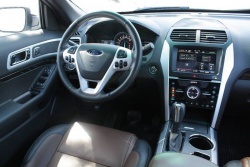 2011 Ford Explorer Limited 4WD. Click image to enlarge |
The electric power steering also allows for the Explorer’s optional Active Park Assist, part of a $2,400 Technology Package (my tester didn’t have it) that also adds adaptive cruise control with collision warning, rain sensing wipers and Blind Spot Information System (BLIS) with cross traffic alert.
The dashboard is very similar to that in another recently-redesigned Ford SUV, the Edge. My top-end Explorer Limited 4WD tester had Ford’s high-tech MyFord Touch system that, depending on your viewpoint, is either very cool or largely unnecessary. The idea is to keep the driver’s attention on the road by putting basic controls for entertainment, navigation, climate and communications on the steering wheel, and displaying said information in the instrument cluster.
 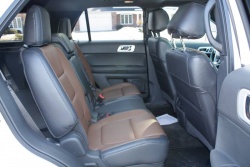 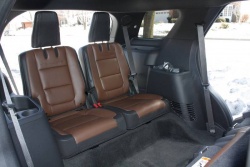 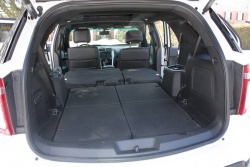 2011 Ford Explorer Limited 4WD. Click image to enlarge |
It’s a handy set-up: changing the temperature, for example, doesn’t require much more eyes-off-the-road time than checking your speed. Still, as I said of the Edge I test-drove a few weeks ago, I think keeping a car interior simple is the best way to keep a driver’s attention on the task of driving.
Regardless of your thoughts on that, MyFord Touch places such a priority on putting information and control at the driver’s fingertips that there are compromises to be found in the traditionally-placed audio and climate controls in the Explorer’s centre stack. The smooth, gloss-black panel and its touch-sensitive controls is slick, but from a lack of distraction point of view, finding any of the controls by touch alone is impossible. Lower-end Explorers get a different stack design with similar controls but with raised buttons that make more ergonomic sense.
MyFord Touch is standard across the Explorer line, and the SYNC Bluetooth communications system is standard in XLT and Limited trims, but not offered in the base model.
With all three rows of seats in place, cargo space is limited to 595 litres (21 cu. ft.) in a well behind the third row, while dropping the third row (power-operated in Limited models with the $900 Luxury Seating Package) increases capacity to 1,240 litres (43.8 cu. ft.). Folding the second row makes for 2,285 litres (80.7 cu. ft.), or more than enough for 35 cases of Girl Guide cookies, in case you were wondering.
Explorer pricing starts at $29,999 for a base trim, front-wheel drive model. That price includes a power driver’s seat, cruise control, steering wheel-mounted audio controls, automatic headlights and speed-sensing wipers. To get into a Limited 4WD version like my tester, the starting bid is $44,199. To that, Ford added the $1,750 dual-panel moonroof, navigation (a relative steal at $700) and the $900 Luxury Package off power-folding third-row seat, perforated leather seating, cooled front seats and 10-way power adjustable front seats. Altogether, it added up to $47,549 before freight and taxes.
The new Explorer’s less truck-like construction may turn off some former owners, but it’s a move that shows Ford is in touch with how its SUVs and crossovers are being used. In many ways, it’s just as impressive as the Flex that came before it, with added helpings of off-road and towing ability to sweeten the pot for those who require (or crave) such attributes. Ford took a chance on changing the Explorer, but they got it right.
|
Pricing: 2011 Ford Explorer Limited 4WD
Specifications
Competitors
Crash test results
|











